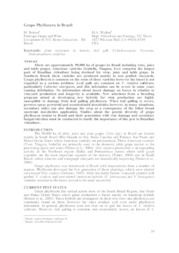Grape phylloxera in Brazil.
Grape phylloxera in Brazil.
Autoria: BOTTON, M.; WALKER, M. A.
Resumo: There are approximately 90,000 ha of grapes in Brazil including wine, juice and table grapes. American varieties (Isabella, Niagara, Ives) comprise the largest part of Brazilian viticulture being destined for wine, juice and table grape. In Southern Brazil, these varieties are produced mainly in non grafted vineyards. Grape phylloxera is common on the roots of these varieties however the insect is not regarded as a serious problem. Leaf galls are common on V. vinifera cultivars, particularly Cabernet sauvignon, and this infestation can be severe in some years causing defoliation. No information about insect damage on leaves in relation to vineyard production and longevity is available. New selections from a breeding program aimed at developing new hybrids for wine production are highly susceptible to damage from leaf galling phylloxera. When leaf galling is severe, growers spray pyretroid and neonicotinoid insecticides however, in many situations, secondary mites can also damage the crop as a consequence of the foliar broad spectrum insecticides application. Studies about the genetic diversity of grape phylloxera strains in Brazil and their association with vine damage and secondary fungal infection must be conducted to clarify the importance of this pest to Brazilian viticulture.
Ano de publicação: 2009
Tipo de publicação: Artigo de periódico
Unidade: Embrapa Uva e Vinho
Palavras-chave: Brasil, Filoxera, Praga de Planta, Uva, Viticultura
Observações
1 - Por padrão são exibidas publicações dos últimos 20 anos. Para encontrar publicações mais antigas, configure o filtro ano de publicação, colocando o ano a partir do qual você deseja encontrar publicações. O filtro está na coluna da esquerda na busca acima.
2 - Para ler algumas publicações da Embrapa (apenas as que estão em formato ePub), é necessário ter, no celular ou computador, um desses softwares gratuitos. Sistemas Android: Google Play Livros; IOS: iBooks; Windows e Linux: software Calibre.
Acesse outras publicações
Acesse a Base de Dados da Pesquisa Agropecuária (BDPA) para consultar o acervo completo das bibliotecas da Embrapa.

